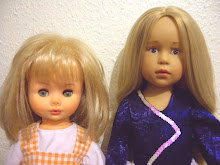Ride a cock-horse to Banbury Cross,
To see a fine lady upon a white horse;
With rings on her fingers and bells on her toes,
And she shall have music wherever she goes.
 |
| Nicholas James and Florence as 'Ride a Cock Horse' at the 2012 Sasha Festival |
In fact, the idea came in 2011 before I even had Florence, I had baby Mabel (my first Sasha) but I was in the process of buying Florence. The Nursery Rhyme theme was the most appealing because of a rhyme which comes from near where I live, but how to do this became something I thought about on my way to work in the mornings. I spent some time researching the origins of the rhyme 'Ride a Cock Horse', the most likely period and therefore also what the lady's costume should be like. I even requested an old book via the local library to find out more about riding habits of the period as well as undergarments because I wanted the whole ensemble to be as historically accurate as possible. I purchased the white horse from the USA via eBay - an incredibly lucky find and I gave it to my younger girl for Christmas 2011.
This is what I compiled and displayed with the entry:
The identity of the ‘fine lady’ is said to be either Queen Elizabeth 1, Lady Godiva or Lady Celia Fiennes (7 June 1662 – 10 April 1741). There is no real evidence to support any of these cases; however this display is based on Lady Celia Fiennes, on the grounds that the line should be 'To see a Fiennes lady'.Lady Celia, whose brother was William Fiennes, 3rd Viscount Saye and Sele (c. 1641-1698) of Broughton Castle, Banbury, was the first woman to ride on horseback to every county in England, between 1684 and about 1712 , accompanied by a couple of servants. She wrote about all her journeys in her diary, describing the places she visited, and she came to Stony Stratford in Buckinghamshire, and on two other journeys rode to Banbury, one of these coming close to Stony Stratford.
Thence to Stony Stratford, so Cross ye river Aven again 12 mile, and Enter Buckinghamshire. At Stony Stratford wch is a little place built of stone they make a great deale of bonelace and so they do all here about, its the manuffactory of this part of ye Country, they sit and worke all along ye streete as thick as Can be.
Banbury is a pretty little town, the streets broad and well pitched, the whole Country is very pleasant and the land rich – a red earth. They make some of their fences with stones – dry walls without Morter. It seemes much on a flatt and you have a large prospect, from thence to London we go by Alesbury 20 mile, thence to London 30 mile.
Local Stony Stratford legend has it that the ‘cock-horse’ is from the famous ‘Cock Hotel’, a 15th century coaching Inn which served many passengers in the great days of coach travel. The Cock Hotel is next door to The Bull Hotel, and travellers visiting each Inn vied with each other to tell outrageous tales of the road, known as ‘cock and bull’ stories.
‘Lady Celia’ wears:
- A full length sleeveless linen chemise, trimmed with old lace
- A full length gathered ‘petticoat’ skirt fastened with a button, hand embroidered with feather stitch
- A matching riding jacket, hand embroidered with feather and satin stitch, and trimmed with bead buttons
- A doublet of patterned brocade, trimmed with bead buttons and hand-made loop button holes
- Gathered lace wristlets
- A cravat made of old lace
- A black felt hat trimmed with feathers, old lace and hand embroidery
- White knitted long socks (hidden in the boots)
- Knee high Black leather boots (made by Lisa Hartley), trimmed with gold bells
- Rings on her fingers made with embroidery thread and beads
- Linen shirt with gathered wrists
- Brown knee length breeches
- Long knitted socks
- Black shoes (Sasha Marina shoes)
Making the Ride a Cock Horse outfits
 |
| The Riding Hat from above |
 |
| Front view of the Riding Hat |
 |
| The hand embroidered Riding Jacket |
 |
| Close up of the jacket embroidery |
 |
| Close up of the jacket embroidered right cuff |
 |
| Close up of the jacket embroidered left cuff |
 |
| The riding skirt |
 |
| Button and fastening on the skirt |
 |
| Hand embroidered hem of the riding skirt |
 |
| The riding jacket and skirt, doublet and chemise |
 |
| The lace trimmed chemise |
 |
| detail of the chemise hem |
 |
| The doublet |
 |
| close up of the doublet buttons and fastenings |
 |
| The riding hat, wristlets, lace cravat and rings on her fingers |
 |
| close up of the rings on her fingers |
 |
| The lace wristlets |
 |
| The ostler's simple shirt and breeches |
 |
| Ostler's shirt with gathered cuffs |
 |
| Ostler's breeches with drawstring waistband |
I got a great deal of pleasure from designing and creating this Dress a Sasha entry.
References:
Through England on a Side Saddle in the Time of William and Mary http://www.visionofbritain.org.uk/text/contents_page.jsp?t_id=Fiennes, freely available electronic version available at ‘A Vision of Britain through Time’, with maps and hyperlinks to the places mentioned.http://digital.library.upenn.edu/women/fiennes/saddle/saddle.html
http://www.mkheritage.co.uk/mkm/stonystratford/docs/history.html
http://arts-and-heritage-stony-stratford.co.uk/2012/05/the-cock-bull-window-competition-can-you-find-the-item-used-by-celia-when-riding-her-cock-horse-to-banbury/
http://www.swereview.co.uk/_local_places_of_interes.htm



















.jpg)






.JPG)





























































.jpg)






































